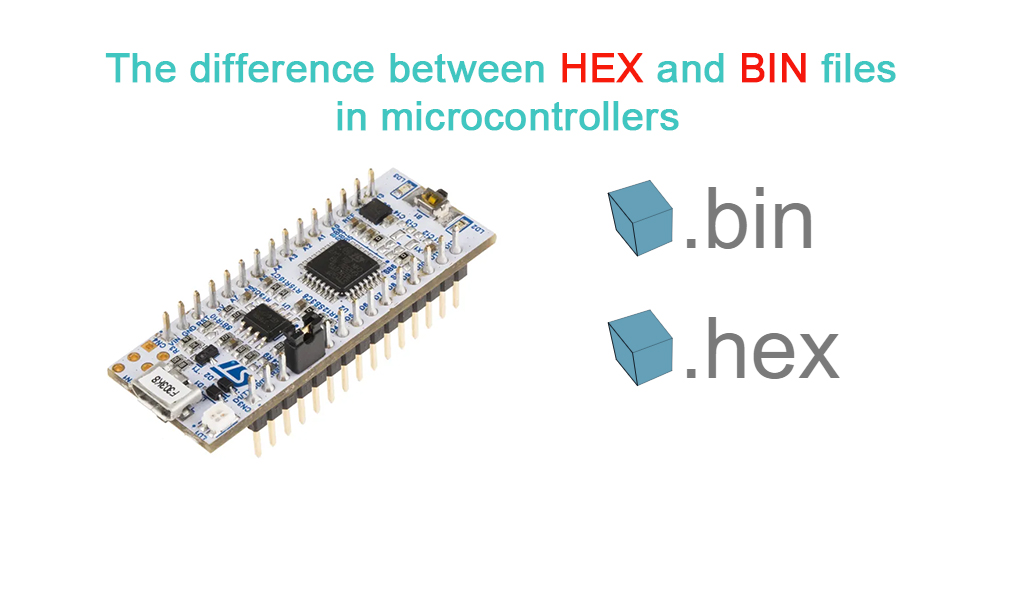
The difference between HEX and BIN files in microcontrollers
Global electronic component supplier AMPHEO PTY LTD: Rich inventory for one-stop shopping. Inquire easily, and receive fast, customized solutions and quotes.
In microcontroller development, HEX (Intel HEX) and BIN (binary) files are two common formats used to store and transfer firmware. Here’s a breakdown of their differences, purposes, and when to use each:

1. Binary (BIN) File
-
Format: Raw binary data (0s and 1s) representing the exact machine code to be written to the microcontroller's flash memory.
-
Contents:
-
Pure executable code + data (no additional metadata).
-
Addresses are implied by the file offset (e.g., the first byte is loaded at the base address).
-
-
Pros:
-
Smaller size (no overhead).
-
Directly writable to flash memory (e.g., via STM32 bootloader).
-
-
Cons:
-
No address/location information (must be specified separately during flashing).
-
No checksums or error detection.
-
-
Typical Use Cases:
-
Flashing via tools like
stm32flash,OpenOCD, or USB DFU. -
OTA (Over-the-Air) updates where bandwidth matters.
-
2. Intel HEX (HEX) File
-
Format: ASCII text file with addresses, data, and checksums in a standardized format.
-
Contents:
-
Each line contains:
-
Start code (
:). -
Byte count, address, record type (data, EOF, etc.).
-
Data payload + checksum.
-
-
Supports non-contiguous memory regions (gaps are handled explicitly).
-
-
Pros:
-
Self-contained address information.
-
Built-in error detection (checksums).
-
Human-readable (can be inspected with a text editor).
-
-
Cons:
-
Larger file size (due to ASCII encoding and metadata).
-
Requires parsing before flashing.
-
-
Typical Use Cases:
-
Debugging (easier to analyze).
-
Flashing via IDEs (Keil, IAR, STM32CubeProgrammer).
-
EEPROM programming (where addresses matter).
-
Key Differences
| Feature | BIN File | HEX File |
|---|---|---|
| Format | Raw binary | ASCII text |
| Address Info | Not included (implied) | Explicitly included |
| Size | Compact (no overhead) | Larger (due to metadata) |
| Checksums | No | Yes |
| Human-Readable | No | Yes |
| Flashing | Requires base address input | Self-contained |
When to Use Which?
-
Use BIN:
-
When flashing via bootloaders (e.g., STM32 UART/USB DFU).
-
For OTA updates (minimizes transmission size).
-
When the target address is known and fixed.
-
-
Use HEX:
-
When debugging or analyzing firmware.
-
When flashing via IDEs (e.g., STM32CubeIDE automatically generates HEX).
-
For EEPROM or non-contiguous memory layouts.
-
Conversion Between HEX and BIN
-
HEX to BIN:
Use tools likeobjcopy(GNU Arm Embedded Toolchain):arm-none-eabi-objcopy -I ihex -O binary firmware.hex firmware.bin
-
BIN to HEX:
Specify the base address (e.g.,0x08000000for STM32 flash):arm-none-eabi-objcopy -I binary -O ihex --adjust-vma 0x08000000 firmware.bin firmware.hex
Example HEX File Snippet
:1000000048000020A1010008AD010008B1010008C4 :10001000B5010008B9010008000000000000000020 :0400200000000000B8 :00000001FF
-
:10= 16 bytes of data. -
0000= Address offset. -
00= Record type (data). -
C4= Checksum.
STM32-Specific Notes
-
STM32CubeIDE: By default generates both
.hexand.binfiles (configurable in project settings). -
Flashing Tools:
-
ST-Link Utility: Supports both HEX and BIN.
-
STM32CubeProgrammer: Prefers HEX but accepts BIN (requires address input).
-
Summary
-
BIN: Simpler, smaller, but lacks metadata. Best for production flashing.
-
HEX: Self-documenting, safer for debugging. Used during development.
Choose based on your toolchain and requirements!
Related Articles
- ·How to Create a PCB for STM32?
- ·How to Make a STM32 CNC 4 Axis?
- ·UART Serial Communication Experiment Based on Raspberry Pi 4B and STM32
- ·How to choose STM32 clock?
- ·Which is better for beginners: ESP32 or STM32? A robot example
- ·The Application of Embedded Electronics in the Field of Consumer Electronics
- ·Application of Embedded Systems in Industrial Robots
- ·Application of Embedded Systems in Aerospace and Defense Fields
- ·The Application of Embedded Systems in the Medical Field
